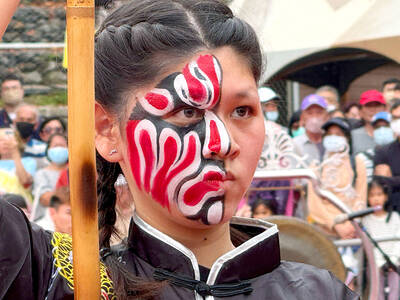How Are You, Dad (爸,你好嗎) is director Chang Tso-chi’s (張作驥) response to his late father, a veteran soldier who fled to Taiwan with Chinese Nationalist Party troops, and before his death admonished his son to make a film he could understand. Five years after he passed away, Chang, whose films are usually in Hakka and Hoklo [commonly known as Taiwanese], produced a compilation of 10 short stories in Mandarin about 10 different fathers and their relationships with their children.
The father figure, biological or symbolic, has always played an important part in Chang’s works. The sons, sometimes suffering from the Oedipus complex, are often abandoned and separated from their fathers, who are often alcoholics, gamblers or criminals. Some critics have compared Chang’s father-son relationships with Taiwan’s relationship towards Japan and China.
In How Are You, Dad, the father figures are more diverse, which allows viewers from different backgrounds to identify and emphasize with the characters that include a tough gangster played by Jack Kao (高捷), who melts before his daughter after she is paralyzed in a diving accident, a young single dad played by Gau Meng-jie (高盟傑), who is lost, drunk and sobs uncontrollably beside his infant son and a Taiwanese businessman who is too busy to spend time with his kids but is willing to sacrifice his life for them.
Many of Chang’s signature themes are revisited here. His interest in identity is touched upon in the story of a half-Japanese, half-Taiwanese transvestite, and his enthusiasm for magical realism is realized through CGI zoo animals in the tale of a Hong Konger actor and his son, who is severely brain damaged.
While many of the stories try too hard, Chang excels in capturing the subtle and nuanced emotions of everyday life. Iron Gate (鐵門) opens with a familiar scene: an extended Taiwanese family having dinner at the aged father’s home. In three long takes, Chang masterfully conveys the in-laws’ bickering and veiled bitterness and the loneliness of the old man, who sits my himself in his quiet house after his sons and daughters rush back home.
In The Sight of Father’s Back (背影), veteran actor Chen Mu-yi (陳慕義) plays a small-town worker who ferries his son to the train station on his rusty old truck after working a night shift to pay for the child’s school outing. The story paints an unforgettable image of a traditional father figure: reticent, reserved and awkward when it comes to showing his emotions and love for his offspring.
Another stand-out story is The Old Time Dream (昨日舊夢). Though nothing much takes place, the audience is quickly drawn into the witty conversation a father, son and grandson engage in at the dining table. The minutes-long dialogue is enough to paint a familial scene that tugs at the heartstrings: a widowed Mainlander lives alone in Taipei after his son and three daughters long since ago moved to Singapore and the US.
When he comes back to visit, the grown-up son looks amazedly at his father, feeling disturbed by the thought that he no longer knows the old man standing before him.

The People’s Republic of China (PRC) last week offered us a glimpse of the violence it plans against Taiwan, with two days of blockade drills conducted around the nation and live-fire exercises not far away in the East China Sea. The PRC said it had practiced hitting “simulated targets of key ports and energy facilities.” Taiwan confirmed on Thursday that PRC Coast Guard ships were directed by the its Eastern Theater Command, meaning that they are assumed to be military assets in a confrontation. Because of this, the number of assets available to the PRC navy is far, far bigger

The 1990s were a turbulent time for the Chinese Nationalist Party’s (KMT) patronage factions. For a look at how they formed, check out the March 2 “Deep Dives.” In the boom years of the 1980s and 1990s the factions amassed fortunes from corruption, access to the levers of local government and prime access to property. They also moved into industries like construction and the gravel business, devastating river ecosystems while the governments they controlled looked the other way. By this period, the factions had largely carved out geographical feifdoms in the local jurisdictions the national KMT restrained them to. For example,

The remains of this Japanese-era trail designed to protect the camphor industry make for a scenic day-hike, a fascinating overnight hike or a challenging multi-day adventure Maolin District (茂林) in Kaohsiung is well known for beautiful roadside scenery, waterfalls, the annual butterfly migration and indigenous culture. A lesser known but worthwhile destination here lies along the very top of the valley: the Liugui Security Path (六龜警備道). This relic of the Japanese era once isolated the Maolin valley from the outside world but now serves to draw tourists in. The path originally ran for about 50km, but not all of this trail is still easily walkable. The nicest section for a simple day hike is the heavily trafficked southern section above Maolin and Wanshan (萬山) villages. Remains of

Shunxian Temple (順賢宮) is luxurious. Massive, exquisitely ornamented, in pristine condition and yet varnished by the passing of time. General manager Huang Wen-jeng (黃文正) points to a ceiling in a little anteroom: a splendid painting of a tiger stares at us from above. Wherever you walk, his eyes seem riveted on you. “When you pray or when you tribute money, he is still there, looking at you,” he says. But the tiger isn’t threatening — indeed, it’s there to protect locals. Not that they may need it because Neimen District (內門) in Kaohsiung has a martial tradition dating back centuries. On